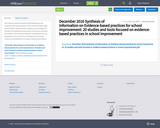
This resources will provide additional guidance to schools and districts reviewing research related to evidence-based improvement strategies to determine , if there is alignment to the tiers of evidence found within ESSA.

This resources will provide additional guidance to schools and districts reviewing research related to evidence-based improvement strategies to determine , if there is alignment to the tiers of evidence found within ESSA.

This resource review focused on identifying tools and resources that may be useful as SEAs and LEAs follow steps of an evidence-based decision-making cycle (see figure) to identify and implement interventions to improve outcomes for students. The resources and tools included here are not exhaustive, but can serve as a starting point for further review and identification of evidence-based interventions.

The purpose of these profiles is to demonstrate what evidence-based decision making looks like in practice. By highlighting this process, these profiles will help to guide others with important points to consider as they use evidence to select and implement interventions to improve student outcomes.
This project identified four sites to profile (states and districts) that promote promising practices in the selection and implementation of evidence-based interventions to improve student and teacher outcomes. Among the promising practices highlighted are examples of how in 2009-2012 these sites used evidence to select interventions that have the potential to align to the new
standards for levels of evidence as described in ESSA. The profiles document the promising practices, successes, challenges, and lessons learned related to the implementation of evidence-based practices in these sites.

This resources is intended for schools and districts to investigate evidence-based improvement strategies to determine the type of research (if it meets the requirements within ESSA), the size of the research, the population and setting, and the results of the research.